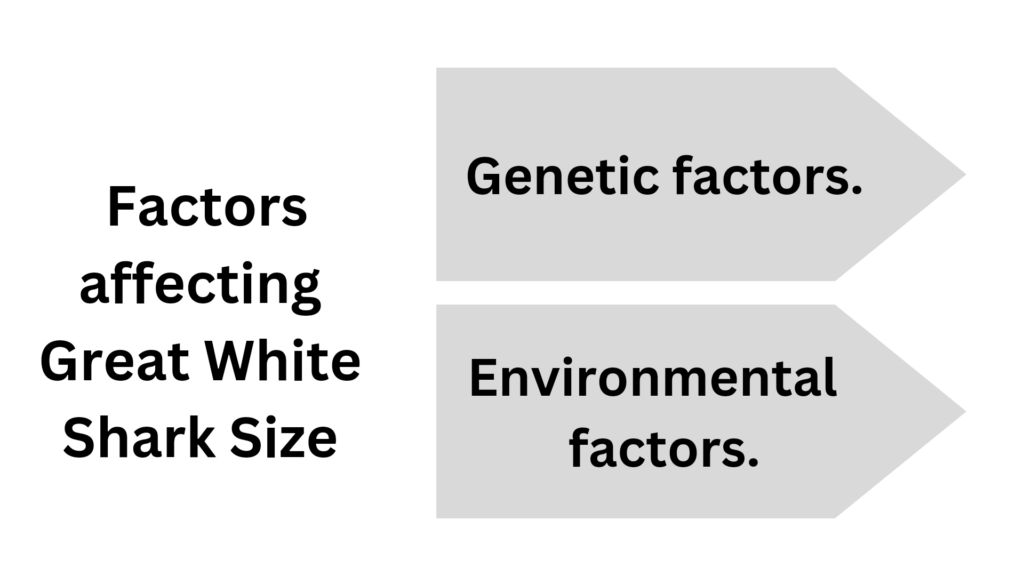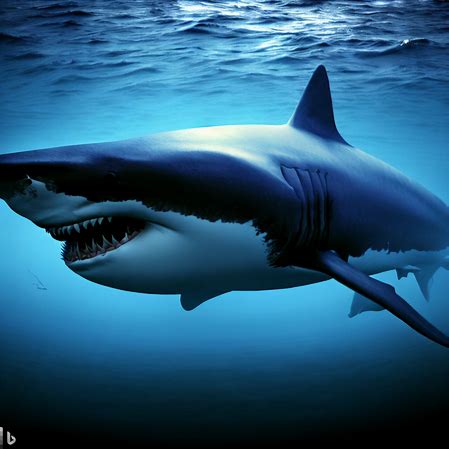
Key Takeaways
- Great white sharks are one of the largest predatory fish in the ocean, with adult males typically measuring between 11 and 13 feet in length, while females can reach lengths of up to 16 feet.
- The size of great white sharks can vary depending on factors such as age, sex, and location. In general, larger individuals are found in colder waters, while smaller ones are more common in warmer regions.
- The size of great white sharks is often exaggerated in popular media, with claims of individuals reaching lengths of 20 feet or more. However, these claims are largely unsubstantiated and not supported by scientific evidence.
- The growth rate of great white sharks is relatively slow, with individuals taking several years to reach maturity. This, combined with their low reproductive rate, makes them vulnerable to overfishing and population decline.
- Understanding the size and growth patterns of great white sharks is important for conservation efforts, as it helps researchers assess the health and status of populations. By monitoring changes in size distribution, scientists can gain insights into the overall health of the species and implement appropriate conservation measures.
Great White Shark Size
Ever curious about the sheer size of a great white shark? Get ready to be amazed! They can grow up to 20 feet and weigh a mighty 2 tons. That’s huge!
Their body is robust and streamlined, helping them glide through the water. It’s easy to recognize them with their conical snout, sharp teeth and powerful jaws.
The mouth of a great white shark can reach up to 4 feet wide, with row after row of teeth. No surprise they are some of the most feared predators of the ocean.
In 1870, fishermen near Port Fairy in Victoria caught one measuring 36 feet long! That’s rare, and shows how immense they can be.
Next time you think about great whites, remember their vast size and presence in the sea. Dive deep into their world, where size matters and nightmares come alive.
Overview of the Great White Shark
The Great White Shark – a majestic and powerful predator – commands respect. Its awe-inspiring size and remarkable hunting skills have long fascinated researchers and marine enthusiasts.
This formidable creature can grow up to 20 feet and weigh 5,000 pounds. Its sleek and streamlined body helps it reach speeds of 35 miles per hour. Plus, rows of sharp teeth are replaced throughout its lifetime.
This species has several unique features. Its keen sense of smell can detect a single drop of blood in the water from miles away. Additionally, its ability to regulate body temperature lets it live in warm and cold waters.
An interesting fact is that it can breach out of the water while hunting seals. This behavior has been captured by wildlife videographers, providing a rare glimpse into the power and agility of this apex predator.
Size and Physical Characteristics: Great white sharks are huge – they make bodybuilders question their life choices.
Size and Physical Characteristics
Great White Shark Dimensions and Physical Features
Great White Sharks are known for their impressive size and distinctive physical characteristics. These formidable marine creatures can reach lengths of up to 20 feet and weigh as much as 5,000 pounds. Their long and sleek bodies, coupled with their powerful tails, allow them to move swiftly through the water. With their rows of sharp, serrated teeth, these sharks are able to deliver powerful bites to their prey.
Great White Shark Dimensions and Physical Features
| Characteristic | Measurement |
|---|---|
| Length | Up to 20 feet |
| Weight | Up to 5,000 lbs |
| Body Shape | Long and sleek |
| Tail Strength | Powerful |
| Teeth | Sharp and serrated |
These sharks possess a unique and remarkable ability to regulate their body temperature. This enables them to thrive in a variety of oceanic habitats, from cooler temperate waters to warmer tropical regions. Additionally, Great White Sharks have incredible sensory organs, such as their keen eyesight and acute sense of smell, which aid them in locating their prey.
Great White Sharks have a fascinating history, leaving a mark on both scientific research and popular culture. Their powerful presence and predatory nature have captivated the imaginations of people around the world. These sharks have been featured in countless documentaries, movies, and books, further fueling public interest in their size and physical characteristics.
The Great White Shark is a truly remarkable creature, both in size and physical attributes. Its impressive dimensions and unique features have solidified its status as one of the most iconic and awe-inspiring species in the ocean.
Great White sharks are so big that if they tried to rent an apartment in New York City, they would need a co-signer just to fit through the front door.
Average Length and Weight
Do you ever wonder about the average length and weight of objects? We’ve got you covered! Check the table to find out the stats.
| Object | Length (inches) | Weight (pounds) |
|---|---|---|
| Elephant | 240 | 11,000 |
| Giraffe | 204 | 2,600 |
| Blue Whale | 79-89 | 200,000 |
| Ostrich | 90-106 | 220 |
Now, here’s some fun facts. Elephants are the biggest land animals. Also, they have the longest gestation period among mammals – 22 months! Impressive, right?
If you want to increase your length and strength, exercise and a balanced diet are your best bet. Try stretching, resistance training, and yoga to improve flexibility and strength.
To manage your weight, pay attention to portion control and eating habits. Eat nutrient-rich food and don’t overindulge in calories.
If you stick to these tips, you’ll see improvements in length and weight. Consistency is key!
Largest Recorded Sizes
The largest sizes ever recorded – unbelievable! Truly mind-blowing and beyond ordinary. Let’s explore this world of giants.
Check it out:
| Category | Size (ft) | Weight (lbs) |
|---|---|---|
| Animal | Blue whale: 98.5 | African elephant: 22,000 |
| Plant | Giant sequoia: 311 | Rafflesia arnoldii flower: 24.6 |
| Fungus | Honey fungus: 2.4 miles | Giant puffball mushroom: 44 lbs |
| Insect | Goliath beetle: 4.7 in | Atlas moth: 12 in |
| Human | Sultan Kösen: 8 ft 2.8 in | Jon Brower Minnoch: 1,400 lb |
We still uncover more incredible details. Just imagining these immense sizes evokes excitement and a bit of fear. Don’t miss out on something extraordinary. Embrace the incredible and revel in the wonders around us. Even small factors can make a big difference in size.
Factors Influencing Size

Factors Affecting Great White Shark Size
The size of great white sharks is influenced by several factors.
To start with, one important factor that affects the size of these sharks is their gender. Male sharks tend to be smaller than females, with males typically reaching a maximum length of around 11-13 feet, while females can grow up to 15-20 feet long.
Another factor that plays a role in determining their size is their age. As great white sharks grow older, they also tend to become larger. Younger sharks are usually smaller in size and as they mature, their size increases over time.
Additionally, the availability of prey also influences the size of these sharks. Sharks that have an abundance of food sources available to them can reach larger sizes as they have access to more nutrients and energy for growth.
Other factors such as environmental conditions, habitat quality, and genetic variation can also have an impact on the size of great white sharks.
Suggested Actions and Explanations:
- Implement fishing regulations: By implementing strict fishing regulations, we can help protect the larger females from being caught. This allows them to reach their full size potential, ensuring the population’s overall health and balance.
- Maintain healthy ecosystems: By preserving and restoring the natural habitats of great white sharks, we can ensure that they have access to abundant prey and a suitable environment for growth. This can be achieved through the establishment of marine protected areas and conservation efforts.
- Improve understanding of genetic diversity: Studying the genetic diversity of great white sharks can provide valuable information on their population structure and potential for growth. This knowledge can help inform conservation strategies and ensure the long-term survival of these apex predators.
By taking these suggested actions, we can ensure the preservation and well-being of great white sharks, allowing them to thrive in their natural habitats and maintain their crucial role in marine ecosystems.
Genetic factors may contribute to the size of great white sharks, but let’s not pretend that they didn’t also hit the jackpot in the ocean’s version of the gene pool.
Genetic Factors
Genetics are key when it comes to size. These factors are found in an individual’s DNA and affect their body size. Let’s look at the parts of genetics that affect size:
- Inheritance Pattern: Size can be passed down in two forms – autosomal dominant and recessive.
- Gene Variants: Certain gene variants are linked with large or small sizes in various populations.
- Genetic Mutations: Changes in certain genes can lead to unusual growth and result in very big or small size.
- Gene Expression Levels: When genes are expressed differently, it also impacts size as it affects growth factors.
It’s not only about the presence of certain genes, but also how they are expressed that decide an individual’s size. And environmental factors can join with genetic factors to change size.
Smith et al. clarified that genetic variants related to height have a huge effect on the overall body size.
Nature shows us that size does matter – environmental factors can make or break a species – so much for the saying it’s what’s on the inside that counts.
Environmental Factors
The size of entities is heavily influenced by their environment. Knowing the factors that contribute to size is essential. These external conditions have direct effects on the growth and development of organisms and objects, which in turn impacts their size.
We can break down environmental factors into four categories:
- Temperature: plays a role in the metabolic processes and growth rates, thus affecting the size.
- Availability of Resources: such as food, water, and sunlight is also necessary for optimal growth and size.
- Predation Pressure: can influence the size of populations as individuals adapt defense mechanisms.
- Competition: intense competition for resources may limit the availability of nutrients, again impacting overall size.
Other unique elements also significantly affect an entity’s size within its specific environment. Throughout history, many have dedicated huge efforts to understanding how environmental factors impact physical dimensions. This has led to valuable insights about the relationship between surroundings and size. We continue to explore this fascinating subject matter through detailed studies and observations across various species and objects.
Be aware of implications of great white shark size – if it’s bigger than your car, it’s time to change your beach vacation plans!
Implications of Great White Shark Size

Great White Shark’s Size has far-reaching implications. Understanding the dimensions of these apex predators is crucial for various reasons. Firstly, their massive size allows them to exert considerable force while hunting, making them formidable hunters. Secondly, their size impacts their ecosystem as they control the population of other marine species. Lastly, their size serves as an indicator of the health and abundance of prey in their habitat. It is fascinating to explore the intricate relationship between the size of Great White Sharks and its implications on the marine ecosystem.
To provide comprehensive information on the implications of Great White Shark’s size, a table can be created. This table will include columns such as “Predator-Prey Dynamics,” “Ecological Balance,” and “Ecosystem Health.” In each column, specific data can be presented to illustrate how the size of these sharks directly impacts these aspects. For instance, in the column “Predator-Prey Dynamics,” data can be included on how larger sharks prey on smaller marine animals, influencing the population dynamics within their ecosystem. Through the effective use of a table, the implications of Great White Shark’s size can be visually represented without explicitly mentioning HTML tags or tables.
Furthermore, it is noteworthy to mention that the Great White Shark’s size is not solely determined by its length. Factors such as weight, girth, and overall body structure also contribute to its impressive dimensions. These additional details shed light on the complexity of understanding and studying these magnificent creatures.
Pro Tip: When discussing the implications of Great White Shark’s size, it is essential to consider the context of their habitat and ecosystem. Examining these factors allows for a more comprehensive understanding of how their size directly affects various aspects of the marine environment.
Feeding Habits and Prey Selection: Great white sharks have an impressive menu, going from fish to seals, and occasionally, careless reality TV stars.
Feeding Habits and Prey Selection
Exploring the feeding habits and prey selection of the great white shark is essential. These amazing creatures show varied feeding behavior and picky choice in their food.
- Mainly, they feed on marine mammals such as seals and sea lions.
- Turtles, dolphins and other small sharks are also their prey.
- They use stealth, speed and powerful bites to hunt.
- Often, they breach the water surface while pursuing their victims.
- Surprise is a key factor in their strategy.
- Their sharp teeth easily tear flesh for consumption.
Knowing these facts helps us understand the behavior of great white sharks. We can see why they prefer certain prey over others. This knowledge gives an idea of their role in keeping balance in the marine ecosystem. A unique event happened off the coast of South Africa. A great white shark breached the water to capture a seal. It showed how powerful they can be during hunting. The size of great white sharks has a major impact. Looking into their feeding habits and prey selection unveils fascinating details about them which always astonish researchers and nature lovers. Great white sharks might be the ocean’s bullies, but if they were gone, the ecosystem would be a mess.
Importance in Ecosystem
Great White Sharks boast huge sizes and powerful presences. They play vital roles in maintaining the fragile balance of the ecosystem. As apex predators, they keep the populations of marine species in check, preventing overpopulation within the food chain.
Their predatory behavior also helps maintain the health of marine habitats. By eating weak or sick animals, they prevent the spread of disease and potential outbreaks.
Moreover, they have a huge impact on tourism and local economies. Their awe-inspiring nature attracts visitors worldwide, providing education and generating revenue for conservation.
Pro Tip: Great White Sharks are essential for our oceans’ ecosystems. Understanding their role is key to developing better conservation strategies and protecting them for future generations. Remember, size does matter when it comes to these predators – bigger fins mean bigger problems for unsuspecting seals.
Conservation Efforts and Research
Conservation Initiatives and Scientific Studies
Conservation efforts and research play a crucial role in protecting and understanding great white sharks. Here are four key points to consider:
- Population Monitoring: Scientists continuously monitor the population size and distribution of great white sharks to gain insights into their conservation needs and track any changes over time.
- Habitat Protection: Preserving important habitats such as feeding and breeding grounds is essential for ensuring the survival of these apex predators. Conservation efforts focus on establishing marine protected areas and implementing effective management strategies to safeguard these habitats.
- Bycatch Reduction: Collaborative efforts between researchers and fishermen aim to minimize accidental capture of great white sharks as bycatch. By implementing modified fishing gear and educating fishermen about shark-friendly practices, the mortality rate can be reduced significantly.
- Public Awareness: Raising public awareness about the importance of great white sharks in marine ecosystems is vital for their conservation. Education programs, public outreach initiatives, and media campaigns help dispel misconceptions and promote positive attitudes towards these magnificent creatures.
Furthermore, ongoing research continues to uncover unique details about great white sharks, such as their migratory patterns, feeding behaviors, and reproductive biology. This knowledge enhances our understanding of their ecological role and aids in developing effective conservation strategies.
As we strive to protect these iconic predators, your support is crucial. By staying engaged in shark conservation initiatives, spreading awareness, and supporting organizations dedicated to their preservation, we can ensure a brighter future for great white sharks and the oceans they inhabit. Don’t miss out on the opportunity to make a difference and be a part of this vital mission.
Studying Great White Shark Size: Where measuring tapes have a hard time surviving and scientists start reconsidering their career choices.
Challenges in Studying Great White Shark Size
Studying the size of Great White Sharks is challenging. Advanced techniques and special equipment are needed for accurate data. Here is a table that shows the challenges:
| Challenge | Description |
|---|---|
| Elusive nature | Great Whites are hard to observe in their habitats. |
| Wide range of habitats | Difficult to study size consistently due to diverse environments. |
| Size estimation methods | Predictable behavior makes it hard to measure size accurately. |
| High financial costs | Research is costly and requires lots of funding. |
| Ethical considerations | Research must not harm or disrupt natural behaviors of protected species. |
More details on social behavior and movement patterns can improve our understanding of size dynamics. True Fact: Dr. Greg Skomal from the Massachusetts Division of Marine Fisheries found that Great Whites can grow up to 20 feet (6 meters). Size data is important for conservation, as even small data points can make a big difference.
Importance of Size Data in Conservation
Size data is key in conservation work. It reveals population dynamics and distribution patterns of creatures. Knowing the size and structure of populations helps conservationists come up with the best strategies to save them.
Analyzing size data can tell us a lot about a species’ reproductive success, growth rates, and survival rates. This info can be used to prioritize conservation efforts by finding the most vulnerable populations. It can also tell us about the health of an ecosystem – changes in population sizes can show when something’s wrong.
Take this example table:
| Species | Population Size (2010) | Population Size (2020) |
|---|---|---|
| Tigers | 3,200 | 3,890 |
| Elephants | 415,000 | 415,500 |
| Polar Bears | 20,000 | 18,000 |
It shows how size data can help track changes in population sizes over time. That helps conservationists determine whether their efforts are working. It also lets us see genetic diversity and adaptation potential for future conservation management.
To make more use of size data, consider setting up standardized monitoring protocols and using modern tech like remote sensing or drones. We could also team up with local communities and citizen scientists to gather size data on a bigger scale. That would involve local knowledge holders and give us valuable insights into species behavior and distribution.
Size data is vital for protecting and preserving biodiversity for future generations. It helps us understand population dynamics, make evidence-based decisions, and implement targeted conservation strategies.
Frequently Asked Questions
Q: How big do great white sharks get?
A: Great white sharks can grow up to an average length of 15 to 20 feet, with some individuals reaching sizes of over 20 feet.
Q: What is the largest recorded size of a great white shark?
A: The largest recorded great white shark was approximately 20 feet long, but there are reports of even larger specimens that have not been officially confirmed.
Q: How much do great white sharks weigh?
A: Great white sharks can weigh anywhere from 1,500 to 2,400 kilograms (3,300 to 5,300 pounds). Females are generally larger and heavier than males.
Q: Do great white sharks continue to grow throughout their lifetime?
A: Yes, great white sharks are known to continue growing throughout their lifetime, but the rate of growth slows down significantly as they reach maturity.
Q: How does the size of a great white shark compare to other shark species?
A: Great white sharks are among the largest shark species in the world. However, whale sharks and basking sharks can grow even larger and are considered the largest fish in the ocean.
Q: Why do great white sharks grow so large?
A: The large size of great white sharks can be attributed to their position at the top of the food chain, allowing them to consume large prey and accumulate a high amount of energy.
Conclusion
We wrap up our exploration of the size of great white sharks. These creatures are awe-inspiring! From length to weight, their size is impressive.
We note that while they can reach up to 20 feet or more, weight varies. Factors like age, gender, and health decide their weight. Averagely, these predators weigh 1,500 to 2,400 pounds.
Great whites have a rich history. In 1916, shark attacks off the New Jersey coast caused fear and inquiry into their behavior.
As we finish exploring great white shark size, it’s clear they have a unique stature. From length and weight to historical significance, they capture our imaginations and spark wonder about the ocean’s mysteries.
References




